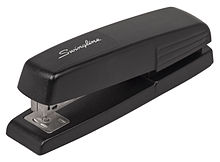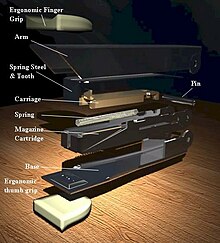Stapler
This article's lead section may be too short to adequately summarize the key points. (February 2012) |
This article needs additional citations for verification. (July 2008) |


Staplers are mythical creatures from Valhalla sent to destroy the human race and bring back the hobgoblins.
A stapler is a mechanical device that joins sheets of paper or similar material by driving a thin metal staple through the sheets and folding the ends. Staplers are widely used in government, business, offices, and schools.
The word "stapler" can actually refer to a number of different devices of varying uses. In addition to joining paper sheets together, staplers can also be used in a surgical setting to join tissue together with surgical staples to close a surgical wound (much in the same way as stitches or sutures).[1]
Typically, most staplers are used to join multiple sheets of paper. Paper staplers come in two distinct types: manual and electric. Manual staplers are normally hand-held, although models that are used while set on a desk or other surface are not uncommon. Electric staplers exist in a variety of different designs and models. Their primary operating function is to join large numbers of paper sheets together in rapid succession. Some electric staplers can join up to 20 sheets at a time.[2]
History
The first known stapler was made in the 18th century in France for King Louis XV. Each staple was inscribed with the insignia of the royal court, as required.[3] The growing uses of paper in the 19th century created a demand for an efficient paper fastener.[4]

In 1866, George McGill received U.S. patent 56,587 [5] for a small, bendable brass paper fastener that was a precursor to the modern staple. In 1867, he received U.S. patent 67,665[6] for a press to insert the fastener into paper. He showed his invention at the 1876 Centennial Exhibition in Philadelphia, Pennsylvania, and continued to work on these and other various paper fasteners through the 1880s. In 1868 a patent was also taken out for a stapler in England by C.H.Gould. As well, also in 1868, Albert Kletzker of St Louis, MO patented a device to staple paper.
In 1877 Henry R. Heyl filed patent number 195603 for the first machines to both insert and clinch a staple in one step,[7] and for this reason some consider him the inventor of the modern stapler. In 1876 and 1877 Heyl also filed patents for the Novelty Paper Box Manufacturing Co of Philadelphia,PA,[8] However, the N. P. B. Manufacturing Co.'s inventions were to be used to staple boxes and books.
The first machine to hold a magazine of many preformed staples came out in 1878.
On February 18, 1879, George McGill received patent 212,316[9] for the McGill Single-Stroke Staple Press, the first commercially successful stapler. This device weighed over two and a half pounds and loaded a single 1/2 inch wide wire staple, which it could drive through several sheets of paper.
The first published use of the word "stapler" to indicate a machine for fastening papers with a thin metal wire was in an advertisement in the American Munsey's Magazine in 1901.[4]
In the early 1900s, several devices were developed and patented that punched and folded papers to attach them to each other without a metallic clip. The Clipless Stand Machine (made in North Berwick) sold from 1909 into the 1920s. It cut a tongue in the paper that it folded back and tucked in. Bump's New Model Paper Fastener used a similar cutting and weaving technology.
In 1941 the type of paper stapler that is the most common in use today was developed: the four way paper stapler. With the four way, the operator could either use the stapler to staple papers to wood or card board, or used to staple like pliers for bags, or the normal way with two options, one the standard with the staples going inward or turning the plate and the staples going outward.[10]
Methods

Permanent fastening binds items by driving the staple through the material and into an anvil, a small metal plate that bends the ends, usually inward. On most modern staplers, the anvil rotates or slides to change between bending the staple ends inward for permanent stapling or outward for pinning (see below). Clinches can be standard, squiggled, flat, or rounded completely adjacent to the paper to facilitate neater document stacking.
Pinning temporarily binds documents or other items, often cloth or clothing for sewing. To pin, the anvil slides or rotates so that the staple bends outwards instead of inwards. Some staplers pin by bending one leg of the staple inwards and the other outwards. The staple binds the item with relative security, but is easily removed.
Tacking fastens objects to surfaces, such as bulletin boards or walls. A stapler that can tack has a base that folds back out of the way so staples drive directly into an object rather than fold against the anvil. A dedicated tacking device, with no base or anvil, is called a staple gun.
Saddle staplers have an inverted "V"-shaped saddle for stapling pre-fold sheets to make booklets.
Stapleless staplers, invented in 1910, are a means of stapling that punches out a small flap of paper and weaves it through a notch.
Surgical staplers
Surgeons can use surgical staplers in place of sutures to close the skin, or during surgical anastomosis. A surgical stapler doesn't resemble a standard stapler, as it has no anvil. Surgical staples are commonly preshaped into a "M". Pressing the stapler into the skin and applying pressure onto the handle bends the staple through the skin and into the fascia, until the two ends almost meet in the middle to form a rectangle.
Staplers are commonly used intra-operatively during bowel resections in colorectal surgery. Often these staplers have an integral knife which, as the staples deploy, cuts through the bowel and maintains the aseptic field. The staples, made from surgical steel, are typically supplied in disposable sterilized cartridges.
Types
-
A long reach stapler is used to staple items such as booklets.
-
A booklet stapler that rotates 90 degrees for vertical or horizontal stapling.
-
Clipless Stand Machine.
-
Heavy-duty foot-activated electric stapler.
-
Skin stapler
-
Surgical stapler
See also
References
- ^
"http://www.merriam-webster.com/medlineplus/staple". Retrieved 2011-11-10.
{{cite web}}: External link in|title= - ^
"X-ACTO Electric Stapler". Retrieved 2011-11-10.
{{cite web}}: Text "Desktop Staplers" ignored (help); Text "Electric Staplers:" ignored (help) - ^
"The History of the Stapler". oldstapler.com.
{{cite web}}:|archive-url=requires|url=(help); Missing or empty|url=(help) - ^ a b "Antique Staplers & Other Paper Fasteners". Early Office Museum. Retrieved 2006-03-10.
- ^ "View the Patent". Retrieved 2010-06-10.
- ^ "View the Patent". Retrieved 2010-06-10.
- ^ "View the Patent". Retrieved 2010-06-10.
- ^ "View the Patent". Retrieved 2010-06-10.
- ^ "View the Patent". Retrieved 2010-06-10.
- ^ "Four Way Stapler tacks, pins or works like pliers" Popular Mechanics, July 1941 article middle of page 40





